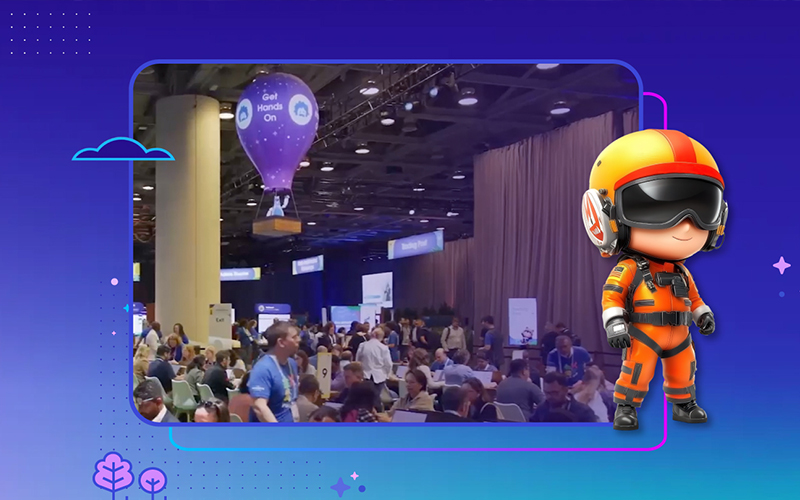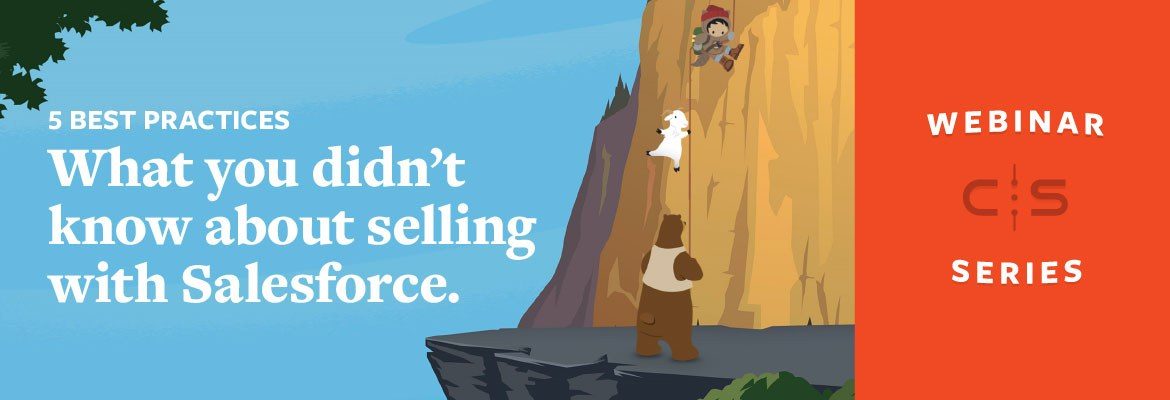
We just released our latest webinar, 5 Best Practices: What You Didn’t Know About Selling with Salesforce. If you didn’t get the chance to watch live, we’ve made the recording available on-demand.
Our very own Global Alliances Manager, Erin Murray, was joined by two Salesforce all-stars, Tara Gonio and Deanna Rayla, to take a deep dive into what it takes to capture the attention of Salesforce and ensure your messaging lands on target.
Tara is a Sr. ISV Solution Manager at Salesforce and has been part of the Salesforce ecosystem for a decade. With experience both on the ISV and Salesforce side, she’s uniquely positioned to share what matters most to the ISV team at Salesforce while having the first-hand experience as an ISV trying to sell with Salesforce.
Deanna is an Associate Manager for the ISV Enablement team at Salesforce and is responsible for helping partners create their ISV value propositions, develop their sales kits, and ensure that they are perfectly positioned to go-to-market with ISV Solution team.
This nearly 50-minute webinar is full of insider tips, tricks, and best practices — we’re surfacing a couple of insights from the webinar to help you kick-start your conversations.
It’s not just who you target; it’s how
Salesforce is a large organization with nearly 40,000 employees. It can be challenging to know who you should reach out to — on top of that, there are over 5,000 other ISVs reaching out and trying to capture mindshare.
The team listed out 5 key roles to focus on to get more business and close more deals.
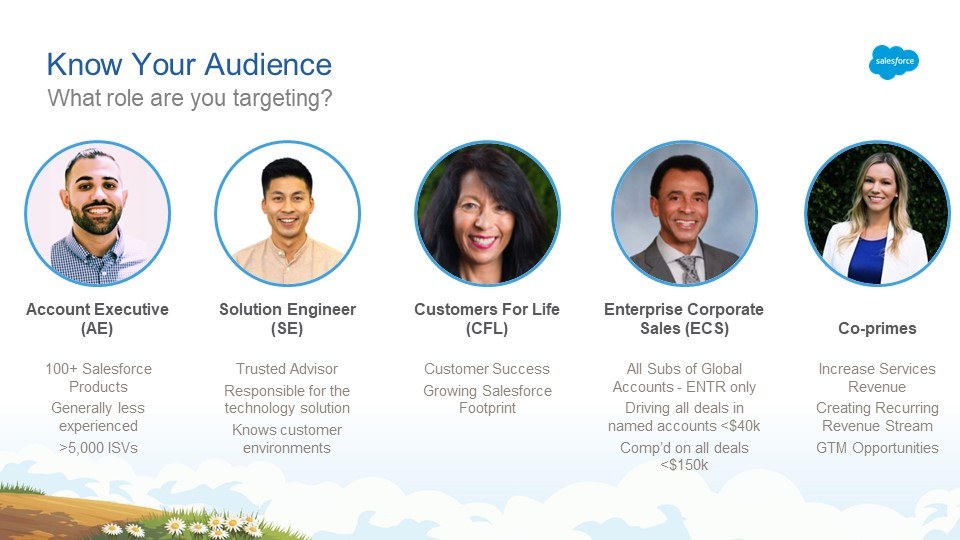
Each group was explored in detail, and key tips on how to position your message to them were shared. Here’s a quick breakdown:
- AEs: Go beyond how you can help them reach quota. Can you de-risk a deal for them or help accelerate their pipeline? Focus on these areas first.
- SEs: Focus on your vision and technology. They are the ones who are responsible for knowing how products integrate with the platform and how your solution makes Salesforce customers’ lives easier.
- CFLs: Understand how your solution can help prevent red accounts. They are a gateway to whitespace because they are on the frontline with customers looking to take full advantage of the platform.
- ECSs: Similar to AEs, but with a strict focus on enterprise accounts that aren’t matched to the core business group in Salesforce.
- Co-primes: Cover different products such as CPQ, Service Cloud, Marketing Cloud, etc. They are experts on specific products on Salesforce. For ISVs with a solution in the products, they can be a tremendous asset, but they will want you to have the same expert-level knowledge they have on their products.
Align with Salesforce’s GTM model
For a business as complex as Salesforce is, it should come as no surprise their go-to-market (GTM) model is just as complex.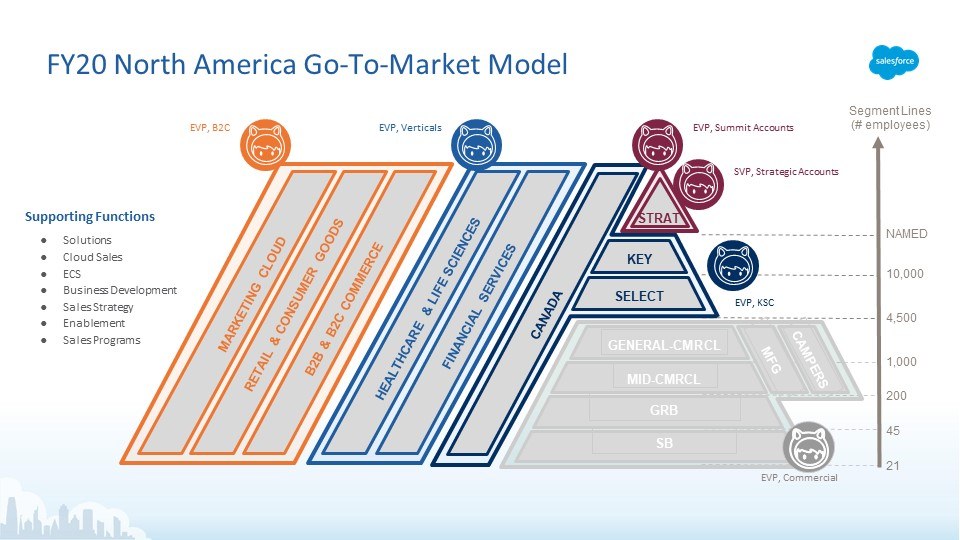
This is the Enterprise GTM model for North America. The grayed-out section is the commercial segment and was covered separately.
Enterprise customers fall into these 3, primary categories:
- At the top of the triangle, are Strategic or Named accounts
- Strategic account teams are responsible for top customers and prospects. There is a designated team that works with each of them.
- Then, there are Key Accounts – which encompass customers with over 10k employees
- And Select accounts – companies with 4500-10k employees
- Note that Canada, Select and Key accounts all roll up to the same EVP
Next to Canada, in blue, there are 2 key verticals, Healthcare and Life Sciences, and Financial Services. These 2 span all business units and fall under the same EVP.
Next to HLS and FinServ, is the B2C division that includes Marketing Cloud, Retail and Consumer Goods, as well as Commerce Cloud.
On the left, you can see a list of supporting roles:
- Solutions is the SE team
- Cloud Sales are the Co-primes
- ECS reps are assigned to the subsidiaries of the Global Accounts, and they’re engaged in any opportunity under $150k
- Business Development – these are INSIDE sales teams who call into companies above 200 employees
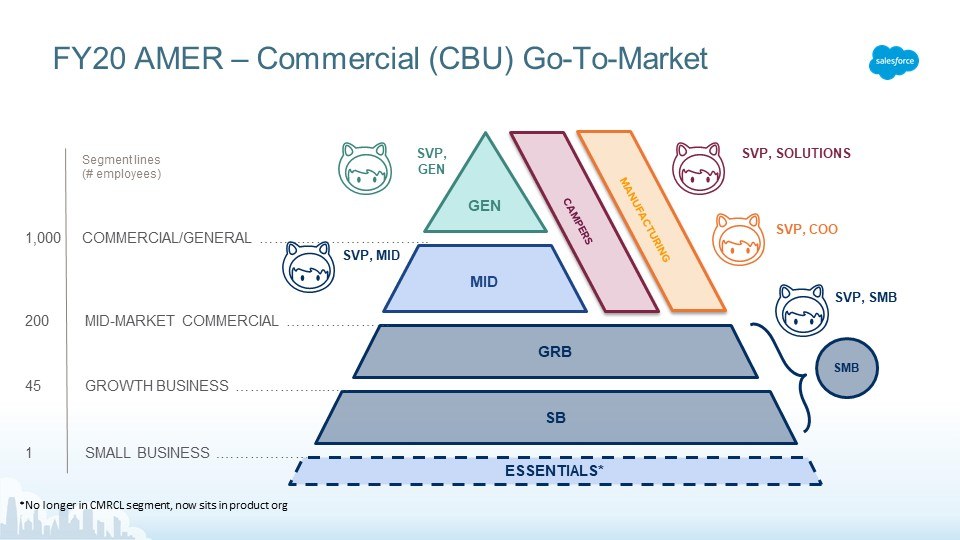
For the Commercial Business Unit (CBU), the GTM is similar. Remember this is the grayed out portion of the triangle above.
Above Essentials, sits the Small Business (SB) and Growth Business (GRB) groups that fall under SMB. SB and GRB and are broken up into 3 territories: West, Central, and Eastern US.
Next, we have the Mid-Market group – 200-1,000 employees, and the General Commercial business group, with companies ranging in size from 1,000 – 4,500 employees.
On the right, we have the Camper customer designation, which is broken out into its own organization. And, next to that, in orange is manufacturing. Salesforce has a team focused on manufacturing companies who fall in Mid-Market and General Business, so between 200-4,500 employees.
The SEs are in the process of switching to an Industry focused model. Meaning the SE teams are starting to be associated with industries vs market segments.
Don’t guess on your sales kit
Your sales kit is a collection of resources you should build out as you work with Salesforce. There are 5 pieces of collateral that will help you in nearly every conversation you have with the team:
- FAQ
- Datasheet
- Customer Stories
- First Call Deck
- Demo
Salesforce wants you to build your sales kit using their templates because it helps the team quickly understand who you are and what your product does in an efficient way. If you are a partner, you can find all the templates at sfdc.co/saleskit. Additionally, you can join the AppExchange (ISV) Business Enablement group at sfdc.co/enableme.
These are just a few of the insights shared during our session. You can access the webinar at any time by registering here.
If you’re looking for a partner to help guide you each step of the way or provide you the expertise for improving your AppExchange product, CodeScience has brought over 250 commercial applications to life on the Salesforce AppExchange and was the first organization to achieve Master Navigator PDO from Salesforce. Contact us today!
